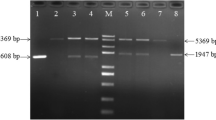Abstract
Aeromonas hydrophila SBK1 (GenBank accession no. HM802878.1), a potent chitinolytic bacterium, was isolated from a pool of 30 chitinolytic isolates. The isolate showed higher chitinolytic activity in respect to clear zone to colony size ratio of 2.15. Maximum production of chitinolytic enzymes, viz., β-N-acetyl-glucosaminidase and chitinase (specific activity 655.3 and 71.6 U mg−1, respectively) by A. hydrophila SBK1 was observed in the synthetic media, containing (w/v)-colloidal chitin, 4.0%; peptone, 0.3%; phosphate, 0.3% (0.15% of each KH2PO4 and K2HPO4); NaCl, 0.25%; MgSO4, 0.05%; KCl, 0.05%; pH 7.0 and at 35°C after 72 h of incubation. Both carbon-to-nitrogen (C/N) and carbon-to-phosphate (C/P) ratio of 13.33 were found optimum for chitinase production. Enzyme productivity increased about twofold in optimized culture condition in respect to its un-optimized state. The crude enzyme showed optimum activity against Culex quinquefasciatus larvae in native water at pH 7.0 and 35°C (LD50 0.60 U ml−1 at 48 h). Therefore, the studied chitinases can be used as an effective mosquitocidal agent.





Similar content being viewed by others
References
Abbott WS (1925) A method of computing the effectiveness of an insecticide. J Econ Entomol 18:265–267
Ahmadi KJA, Yazdi MT, Najafi MF, Shahverdi AR, Faramarzi MA, Zarrini G, Behravan J (2008) Optimization of medium and cultivation conditions for chitinase production by the newly isolated: Aeromonas sp. Biotechnology 7:266–272
Das PK, Amalraj D (1997) Biological control of malaria vectors. Indian J Med Res 106:174–197
Duncan DB (1955) Multiple range and multiple F tests. Biometrics 11:1–42
Felse PA, Panda T (2000) Production of microbial chitinases—a revisit. Bioprocess Eng 23:127–134
Frandberg E, Schnurer J (1994) Chitinolytic properties of Bacillus pabuli K1. J Appl Bacteriol 76:361–367
Gayathri G, Balasubramanian C, Vinayaga Moorthi P, Kubendran T (2010) Larvicidal potential of Beauveria bassiana (Balsamo) Vuillemin and Paecilomyces fumosoroseus (Wize) Brown and Smith on Culex quinquefasciatus (Say). J Biopestic 3:147–151
Gohel V, Singh A, Vimal M, Ashwini P, Chhatpar HS (2006) Bioprospecting and antifungal potential of chitinolytic microorganisms. Afr J Biotechnol 5:54–72
Gooday GW (1990) The ecology of chitin decomposition. Adv Microb Ecol 11:378–430
Guo SH, Chen JK, Lee WC (2004) Purification and characterization of extracellular chitinase from Aeromonas schubertii. Enzyme Microb Technol 35:550–556
Hayashi K, Sato SI, Takano R, Tsujibo H, Orikoshi H, Imada C, Okami Y, Inamori K, Hara S (1995) Identification of the positions of disulfide bonds of chitinase from a marine bacterium, Alteromonas sp. strain O-7. Biosci Biotechnol Biochem 59:1981–1982
Hiraga K, Shou L, Kitazawa M, Takahashi S, Shimada M, Sato R, Oda K (1997) Isolation and characterization of chitinase from a flake-chitin degrading marine bacterium, Aeromonas hydrophila H-2330. Biosci Biotechnol Biochem 61:174–176
Imoto T, Yagishita K (1971) A simple activity measurement of lysozyme. Agric Biol Chem 33:1154–1156
Lee KP, Kim CN, Yu JH, Oh DH (1990) The production and purification of chitinase from Aeromonas salmonicida YA7-625. Korean J Appl Microbiol Biotechnol 18:599–606
Liu M, Cai QX, Liu HZ, Zhang BH, Yan JP, Yuan ZM (2002) Chitinolytic activities in Bacillus thuringiensis and their synergistic effects on larvicidal activity. J Appl Microbiol 93:374–379
Lowry OH, Rosebrough NJ, Farr AL, Randall RJ (1951) Protein measurement with Folin phenol reagent. J Biol Chem 193:265–267
Mathivanan N, Kabilan V, Murugesan K (1997) Production of chitinase by Fusarium chlamydosporum, a mycoparasite to groundnut rust, Puccinia arachidis. Indian J Exp Biol 35:890–893
Nicol S (1991) Life after death for empty shells. New Sci 129:46–48
Ohishi K, Yamagishi M, Ohta T, Suzuki M, Izumida H, Sano H, Nishijima M, Miwa T (1996) Purification and properties of two chitinases from Vibrio alginilyticus H-8. Ferment Bioeng 6:598–600
Roberts WK, Selitrennikoff CP (1988) Plant and bacterial chitinases differ in antifungal activity. J Gen Microbiol 134:169–176
Saitou N, Nei M (1987) The neighbor-joining method: a new method for reconstructing phylogenetic trees. Mol Biol Evol 4:406–425
Shanmugaiah V, Mathivanan N, Balasubramanian N, Manoharan PT (2008) Optimization of cultural conditions for production of chitinase by Bacillus laterosporous MML2270 isolated from rice rhizosphere soil. Afr J Biotechnol 7:2562–2568
Shin WC, Lee DS, Kim TH, Woo JH, Lee JM, Kim JG, Hong SD (1995) Isolation and characterization of Acinetobacter sp. WC-17 producing chitinase. J Microbiol Biotechnol 5:80–86
Souza RF, Soares RMA, Nascimento RP, Coelho RRR, Gomes RC (2005) Effect of different carbon sources on endochitinase production by Colletotrichum gloeosporioides. Curr Microbiol 51:16–21
Suginta W, Robertson PA, Austin B, Fry SC, Fothergill-Gillmore LA (2000) Chitinases from Vibrio: activity screening and purification of chiA from Vibrio carchariae. J Appl Microbiol 89:76–84
Takayanagi T, Ajisaka K, Takiguchi Y, Shimahara K (1991) Isolation and characterization of thermostable chitinases from Bacillus licheniformis X-7u. Biochim Biophy Acta 1078:404–410
Tsujibo H, Orikoshi H, Shiotani K, Hayashi M, Umeda J, Miyamoto K, Imada C, Okami Y, Inamori Y (1998) Characterization of chitinase C from a marine bacterium, Alteromonas sp. strain O-7, and its corresponding gene and domain structure. Appl Envion Microbiol 64:472–478
Usui T, Hayashi Y, Nanjo F, Sakai K, Ishido Y (1987) Transglycosylation reaction of a chitinase purified from Nocardia orientalis. Biochim Biophys Acta 923:302–339
Vaidya RJ, Shah IM, Vyas PR, Chhatpar HS (2001) Production of chitinase and its optimization from a novel isolate Alcaligenes xylosoxydans: potential in antifungal biocontrol. World J Microbiol Biotechnol 17:691–696
Wang SL, Chang WT (1997) Purification and characterization of two bifunctional chitinases/lysozymes extracellularly produced by Pseudomonas aeruginosa K-187 in a shrimp and crab shell powder medium. Appl Environ Microbiol 63:380–386
Acknowledgments
The work was supported by the financial support of the Major Research Project sponsored by University Grants Commission (UGC), New Delhi, India [F.NO.-33-218/2007(SR)].
Author information
Authors and Affiliations
Corresponding author
Additional information
Handling Editor: Helen Roy
Rights and permissions
About this article
Cite this article
Halder, S.K., Maity, C., Jana, A. et al. Chitinolytic enzymes from the newly isolated Aeromonas hydrophila SBK1: study of the mosquitocidal activity. BioControl 57, 441–449 (2012). https://doi.org/10.1007/s10526-011-9405-3
Received:
Accepted:
Published:
Issue Date:
DOI: https://doi.org/10.1007/s10526-011-9405-3




